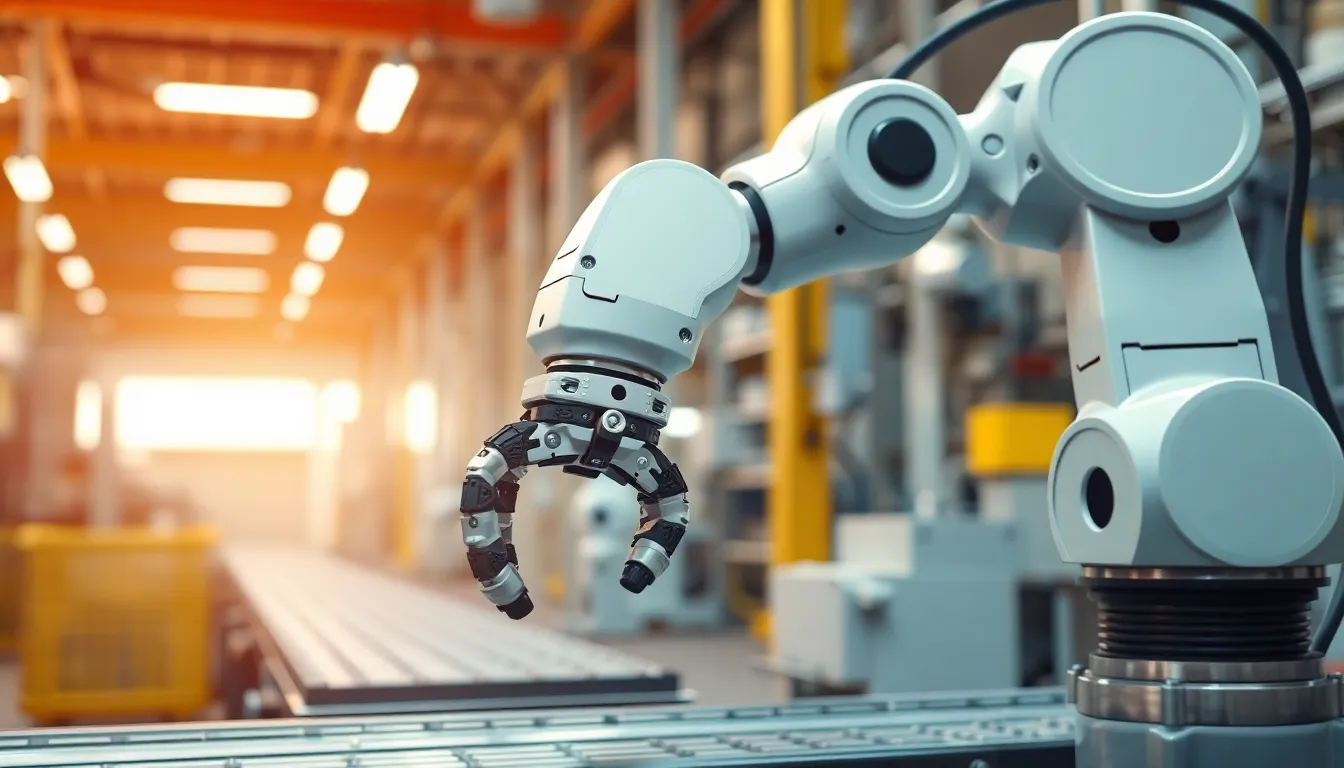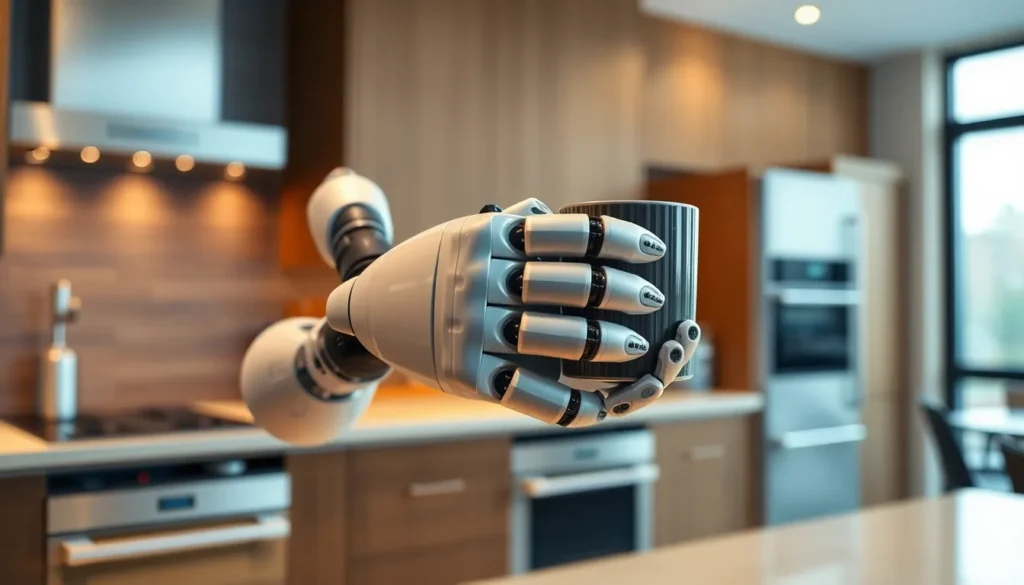In a world where robots are no longer just the stuff of sci-fi dreams, understanding robot dynamics has never been more crucial. Imagine a future where your coffee machine doesn’t just brew but also knows when you need a caffeine boost. That’s the magic of robot dynamics—the science behind how robots move, interact, and sometimes even dance like no one’s watching.
Table of Contents
ToggleOverview of Robot Dynamics
Robot dynamics studies the forces and motions involved in robotic movements. It covers essential principles, including kinematics, which focuses on motion without considering forces, and kinetics, which examines forces that result in motion. Understanding these principles is crucial for creating robots that can navigate and perform tasks effectively.
Factors like mass, inertia, and velocity play significant roles in robot dynamics. Mass influences how force affects an object’s acceleration, defined by Newton’s second law of motion. In parallel, inertia determines how difficult it is to change an object’s motion. Robots equipped with advanced sensors evaluate these elements in real time to maintain stability and efficiency.
The behavior of robots under different conditions varies significantly. Dynamic simulation allows engineers to model various scenarios, ensuring robots respond accurately. This simulation process includes predicting a robot’s response to external forces, such as friction or uneven surfaces.
Robot dynamics also impacts motion planning. When designing paths for movement, robots consider their physical limitations and environmental constraints. Formulating algorithms that account for these dynamics ensures smooth and precise operations.
Research advancements continue to enhance robot dynamics. Innovations in materials and artificial intelligence lead to more agile and adaptive robots. Enhanced sensors and actuators allow robots to interact seamlessly with their surroundings, anticipating changes that require rapid adjustments.
Collectively, these elements form a comprehensive framework for understanding robot behavior in dynamic environments. As research progresses, applications of robot dynamics will expand, directly influencing the automation landscape.
Fundamental Concepts

Understanding robot dynamics includes grasping two essential principles: kinematics and dynamics. Each concept plays a vital role in robot movement and functionality.
Kinematics
Kinematics studies motion without considering the forces behind it. This branch analyzes parameters such as position, velocity, and acceleration in robotic systems. By assessing the trajectory of a robot, engineers can design movements that optimize efficiency. Robot arms in manufacturing showcase kinematic principles as they execute precise tasks. Kinematic models help predict the future position of robots, essential for tasks requiring accuracy. Real-time data from motion sensors enhances these predictions, enabling robots to adapt their movements to dynamic environments. With a solid grasp of kinematics, engineers ensure robots navigate through complex tasks seamlessly.
Dynamics
Dynamics examines the forces leading to motion, essential for understanding how robots interact with their surroundings. Engineers focus on key factors such as mass, inertia, and external forces influencing movement. Dynamic analysis aids in predicting how robots react to obstacles or changes in terrain. For example, a delivery robot must account for weight changes as it picks up or drops off items. By utilizing dynamic models, engineers enhance stability and efficiency in robotic designs. Real-time feedback from advanced sensors allows robots to adjust their actions based on the forces encountered. In this manner, dynamics forms the foundation for creating robots that respond effectively to their environment.
Control Strategies
Control strategies play a crucial role in robot dynamics, ensuring accurate movements and interactions with the environment. Two primary methods exist: open-loop control and closed-loop control.
Open-Loop Control
Open-loop control systems execute commands without feedback. These systems rely solely on pre-set trajectories and inputs. For instance, when a robotic arm performs a specific task like moving to a designated position, it follows a predetermined path without adjusting based on external conditions. The simplicity of open-loop control makes it suitable for tasks where precision isn’t critical. However, challenges arise in dynamic environments where unexpected changes could affect performance. In such cases, relying exclusively on open-loop control can lead to inaccuracies.
Closed-Loop Control
Closed-loop control systems incorporate feedback to adjust movements in real time. By continuously monitoring the robot’s position and performance, these systems can respond to changes and errors effectively. For example, if a robot encounters an obstacle while navigating, it can adapt its path based on sensor data. This feedback loop allows for greater accuracy and reliability when performing complex tasks. Closed-loop control is essential in applications like autonomous vehicles, where dynamic environments require constant adjustments. Flexibility and responsiveness enhance the robot’s ability to function optimally in various scenarios.
Applications of Robot Dynamics
Robot dynamics has significant applications across various sectors. These applications enhance efficiency and functionality, making robots invaluable in modern society.
Industrial Robots
In manufacturing, industrial robots excel in automation tasks. They perform assembly lines, material handling, and quality control operations efficiently. Dynamic models help engineers design robotic arms that replicate human-like movements, ensuring precision in tasks. High payload capacities enable these robots to lift heavy objects with ease. Advanced sensors contribute to their ability to navigate complex environments, adjusting to obstacles in real time. Predictive dynamics allow robots to anticipate changes on the production floor, enhancing workflow and reducing downtime. Companies benefit from increased productivity and minimized errors through these innovations.
Service Robots
Service robots significantly impact industries like hospitality and healthcare. They assist with tasks ranging from delivering items to providing companionship for the elderly. Robot dynamics plays a crucial role in maintaining balance and stability during human interactions or in crowded environments. These machines utilize advanced navigation algorithms to move safely and efficiently around spaces. Feedback from sensors ensures swift responses to dynamic surroundings. As technology evolves, service robots will further adapt to meet varying user needs, improving overall service quality and enhancing user experiences.
Challenges in Robot Dynamics
Robot dynamics faces various challenges that impact performance and functionality. These challenges include real-time processing and nonlinear dynamics, both crucial for enhancing robot capabilities.
Real-Time Processing
Real-time processing is vital for robots to respond effectively to changing environments. Accurate data interpretation from sensors enables robots to make instantaneous decisions. Effective algorithms analyze incoming data swiftly, ensuring timely responses to obstacles or dynamic factors. Processing speed directly influences a robot’s ability to navigate effectively. Limitations in hardware or software can cause delays, diminishing overall performance. Engineers focus on optimizing these systems to enhance responsiveness for improved functionality in diverse applications.
Nonlinear Dynamics
Nonlinear dynamics presents significant complexities in robot movement and control. Many robotic systems experience nonlinear behavior, especially under varying loads and speeds. Understanding these behaviors requires advanced mathematical models to predict motion accurately. Nonlinear effects complicate control strategies, making robust designs essential for stability. Engineers tackle these challenges by developing sophisticated control algorithms that account for nonlinearities. Adapting to these dynamic conditions ensures that robots maintain effective interaction with their environments.
Future Trends in Robot Dynamics
Innovations in robotics are shaping the future dynamics of robots. These advancements will enhance motion planning and improve interaction with environments. New materials, for example, play a significant role in developing lighter and stronger robotic structures. Increased flexibility and agility will emerge as a result of these materials, leading to robots that adapt quickly to dynamic situations.
Artificial intelligence integration is another pivotal trend in robot dynamics. AI allows robots to learn from their surroundings, creating more efficient movement patterns. Through machine learning techniques, robots will predict outcomes based on past experiences and adjust accordingly. Enhanced sensory technologies contribute to this development, offering real-time feedback that facilitates precise actions.
Collaboration between humans and robots also stands to improve in various environments. With advanced dynamics modeling, robots can predict human behavior and adjust their tasks. This predictive capability enhances safety and efficiency in shared spaces, particularly in manufacturing and healthcare settings.
Simulation technologies are evolving, providing more accurate predictions of robot movements. Engineers will employ these simulations to test various scenarios before actual deployment, optimizing robot performance. Enhanced computational power also allows for more complex calculations in real time.
Emerging ethical considerations in robotics impact developments in dynamics. Designers must prioritize safety and reliability with the increased autonomy of robots. Regulations surrounding robot behavior will evolve, ensuring that robot actions remain predictable and manageable in unpredictable environments.
Investment in research and development strengthens these trends. Increased funding across sectors accelerates the creation of innovative dynamic solutions. As a result, the future landscape of robot dynamics promises enhanced performance and greater societal integration.
Robot dynamics plays a crucial role in the evolution of robotics, impacting how these machines interact with their environments. As technology advances, robots are becoming more capable of understanding and adapting to human needs. The integration of enhanced sensors and artificial intelligence is paving the way for more agile and efficient robots.
Future developments in materials and dynamic modeling will further improve robot performance, allowing for seamless collaboration in various sectors. Addressing challenges such as real-time processing and nonlinear dynamics will be essential for optimizing robot functionality. Investment in research and development remains vital for fostering innovation and ensuring that robots can meet the demands of an ever-changing world.










